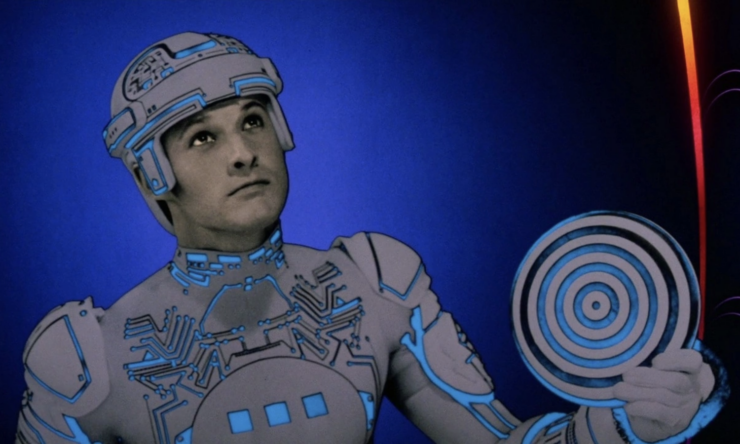Tron (1982) Directed by Steven Lisberger. Screenplay by Steven Lisberger based on a story by Steven Lisberger and Bonnie MacBird. Starring Jeff Bridges, Bruce Boxleitner, David Warner, Cindy Morgan, and Barnard Hughes.
Let’s do a little time warp and cast ourselves back to 1982. Ronald Reagan is president of the United States. Margaret Thatcher is prime minister of the United Kingdom. Argentina occupies the Falkland Islands in a failed attempt to wrest them from British control. Steven Spielberg’s E.T. is released and becomes the most successful movie in the world for the next decade. Michael Jackson’s Thriller is released and becomes the most successful album of all time. Israel invades Lebanon. In Chicago a never-identified murderer slips potassium cyanide into Tylenol capsules and kills seven people. Sony begins selling the world’s first consumer compact disc player. The population of China surpasses one billion.
And Time makes an unexpected choice for Man of the Year: the computer.
Roger Rosenblatt’s cover article for that issue of Time is a truly bizarre glimpse into the past. You should definitely read it. It’s somehow exactly what you would imagine a Time “Machine of the Year” piece from the early ’80s to be. Computers! Newfangled gadgets coming to change the world! Personal computers had been available in various forms for some time, but it was only in the late ’70s and early ’80s that they began to go truly mainstream. There was a massive cultural shift happening, and it’s no surprise that it would be reflected in cinema—both in subject matter and in how movies were made.
When we’re talking about movies, it’s important to clarify what we mean when we say a film is influential. It might mean that a movie was wildly popular upon release and spawned numerous knock-offs and mimics, or it might mean that a movie altered the art and craft of filmmaking or the business of moviemaking. Tron is in the latter category, but it also sits in an odd place in film history.
It wasn’t actually the first film to use computer-generated imagery (CGI) with live-action scenes (that was Westworld, in 1973), but it did very much demonstrate what CGI could do with a lot of work and an expansive imagination. But nobody has ever really tried to make anything like it. Not until they made the sequel, that is. Sure, there were films and TV shows that borrowed elements of the visual style, and everybody gets obsessed with sentient computers now and then, but Tron is the only movie like Tron. It doesn’t quite fit into this month’s film club theme, although it’s a commonly cited influence for a lot of virtual reality films, but it doesn’t fit anywhere else either, and I wanted to talk about it, so here we are.
Tron’s uniqueness is a rare thing in Hollywood, and it’s even more rare because we’re talking about a mainstream film from a significant studio. In 1982, Disney wasn’t anywhere near the cultural juggernaut it is today, but it was still making movies that people watched and liked. Tron wasn’t what anybody expected from Disney; even though the critical response was favorable and it found a respectable audience, it ended up as a financial disappointment. This wasn’t helped by the fact that it came out the same summer as E.T., Raiders of the Lost Ark, Poltergeist, and Star Trek: The Wrath of Khan. There were flashy special effects and big, successful genre movies everywhere in theaters in the summer of 1982. (Tron did better than Ridley Scott’s Blade Runner but worse than Terry Gilliam’s Time Bandits. I don’t know what that says about cinematic trends in 1982. Draw your own conclusions.)
Steven Lisberger got the idea for Tron in 1976 when he encountered Pong, one of the earliest video games ever created. He already had an interest in animation, and he began thinking about how animation could be used to visualize computers and computer games. He spent a few years developing the idea with his business partner, Donald Kushner, before they began shopping it around Hollywood. This led to the project being mentioned in Variety, which caught the attention of computer scientist Alan Kay, who was working at Xerox’s Palo Alto Research Center (PARC) at the time, developing a few little things like, oh, you know, object-oriented programming, graphical user interfaces, the progenitor of modern laptop and tablet computers, and so on. In between all of that work revolutionizing technology and changing the world forever, Kay also found time to persuade Lisberger to use computer-generated images in his planned movie.
(A quick aside for a sweet Hollywood story: During the development of the film, Kay met Bonnie MacBird, who wrote the first several drafts of the Tron script using Kay as inspiration for the character Alan Bradley. In typical Hollywood fashion, multiple rewrites, numerous contributors, and a credits dispute means MacBird is credited for the story but not the screenplay. But throughout all this, MacBird and Kay fell in love and eventually married. They’re still married today.)
Several studios passed on the project. In another timeline or another era, Disney might have passed on it too, but Disney in the early ’80s was going through a bit of a rough patch. Walt Disney had died in 1966, and the company waffled around for a while, not quite sure what to do in his absence. They were producing movies through the 1970s, and many of those films were quite successful (including the 1973 animated feature Robin Hood, which for decades has been responsible for confused tweens developing romantic crushes on a fox). But they were shedding talent (in 1977 Don Bluth and eleven other animators left to form their own company) and films from other companies were getting a lot more hype (e.g., Star Wars). By the time Lisberger and Kushner brought their movie treatment to Disney, the studio wanted something bold and splashy and science fictional.
But they first wanted Lisberger and Kushner to prove they could do it, because the movie would require a heck of a lot of money and use some unfamiliar and unproven techniques. There was some trial and error before they settled on the combination of techniques that make up the final film. The first plan was for all the scenes in the computer world to be animated, but Lisberger and the film’s special effects supervisor, Richard Taylor, decided instead to combine live-action shots with a technique called backlight animation. (Not the Wētā Workshop Richard Taylor. Different Richard Taylor entirely.)
This gets a bit complicated, but it’s also really cool, so bear with me as we take a little field trip into animation school.
In backlight animation, a scene is first photographed normally, except that areas meant to glow brightly and vibrantly are blacked out. Then the scene is photographed again, this time with a counter-matte masking everything except those blacked-out areas, to create a transparency of the scene. Then light is shone through the transparency to be photographed yet again. The light is often modified to achieve the desired effect, using colored gels, filters, meshes, or changing exposure. That’s how animated films from the era created fire and lightning effects, among other things, because it allows for a bright, brilliant element to stand out from the rest of the animation. Don Bluth’s The Secret of NIMH (1982), for example, has some truly beautiful uses of backlight animation.
But Lisberger and Taylor figured that was too easy, I guess, so they decided to add several layers of complexity by combining the animation technique with live-action scenes—and to do it not just for emphasis in a few key scenes, but in every single scene that takes place in the computer world.
Their first idea was to film the actors in gray suits against an all-white background, but cinematographer Bruce Logan (who had worked on the special effects of 2001: A Space Odyssey and Star Wars) convinced them that wasn’t going to work, so they switched to filming the actors in white suits against an all-black background. The white costumes had solid black lines all over them to later be transformed into those distinctive glowing stripes. The scenes were filmed in black and white on 65mm negatives because, quite simply, the more standard 35mm format was just not large enough for what they required. (There were so few working 65mm cameras in Hollywood at the time, the production staff would tell stories about working around missing parts and broken viewfinders.)
The next step was to blow up those 65mm negatives onto large-format Kodalith film, on which everything that was not going to glow (most importantly: the actors’ faces) had to be manually blacked out before the backlight was applied. Because there were so many colors involved, each scene required numerous passes with different filters; some scenes required as many as 50 photographic passes. Then, because everything was filmed against a solid black studio, the characters had to be rotoscoped out and placed against the desired background. The backgrounds are mostly matte paintings—there are some 300 in the film—which get their glow-y, high-tech look from colored filters and light.
The key word here is manually. All of this had to be done by hand. Every single frame of every single scene that shows the actors in the computer world, amounting to about 50 minutes of the movie’s 96-minute runtime. It required truckloads of film and other materials and literally hundreds of post-production staff.
It is—let’s be frank—a completely fucking insane way to make a movie. Don’t get me wrong: it looks great. It is a genuinely brilliant and eye-catching way to create a wholly unfamiliar computer environment. But it’s also no wonder that nobody ever tried anything like it again.
The filmmaking technique that did catch on was, of course, Tron’s use of computer-generated imagery, or CGI. Compared to what we are used to seeing these days, Tron’s 15 minutes of CGI doesn’t feel like much, but at the time it was a tremendous portion of a movie to be made on computer. We see it mostly in the landscapes, vehicles, and buildings in the computer world: the light cycles, the bad guy’s ship that’s totally an Imperial Cruiser, the solar sail gliding through those metal canyons. It’s not really computer animation as we think of it today; each frame was created individually and filmed by sticking a camera in front of the computer monitor. Four companies worked on the computer graphics, and they didn’t work together, so if you’re thinking that certain scenes look very different from other scenes, you are right.
You have by this point no doubt noticed that I’m focusing on how the movie got made, rather than on the content of the movie itself. The reason for that is, alas, I think the real-world, behind-the-scenes story is more interesting. It’s a film that took so many risks, achieved something that nobody else has ever done before or since, heralded so much technical innovation, and had such a lasting impact on how movies are made, but the movie itself is just kind of… fine. It’s fine. There’s some cool and tantalizing stuff in the story, but there’s also a lot that’s not very engaging.
Tron tells the story of a computer programmer named Kevin Flynn (Jeff Bridges, clearly having a ball with the role) who used to work for a giant tech company called ENCOM. His former coworker at ENCOM, a man named Dillinger (David Warner), stole some video games created by Flynn and passed them off as his own. This includes a game called Space Paranoids, a fact that is not relevant to the movie’s plot in any way, I just want to mention it because Space Paranoids sounds like the absolute best video game. (Somebody apparently made it into a real game in 2010, but I don’t want to know about the real game. It’s never going to live up to what I imagine in my head.) Flynn now runs an arcade, where he regularly beats all of his customers on the games during his working hours, and during his downtime he tries to hack into the ENCOM mainframe to retrieve proof that Dillinger stole his work.
Dillinger, meanwhile, has risen to a position of power within ENCOM. Dillinger has developed the Master Control Program (MCP), a sinister artificial intelligence that is making itself stronger by subsuming all kinds of other computer programs, with the ultimate goal of—naturally—taking over the world. Two current ENCOM employees, Alan Bradley (Bruce Boxleitner, also known to sci fi fans as John Sheridan on Babylon 5) and Lora Baines (Cindy Morgan), suspect that Dillinger and his MCP are up to no good. They agree to help Flynn access the ENCOM system to find the proof he needs. The MCP has other ideas, however, and decides—in a delightful example of 1980s science fiction nonsense—to use a giant laser beam to dematerialize Flynn and trap him inside the ENCOM computers. (The laser laboratory in the movie is real: they filmed those scenes at the Lawrence Livermore Laboratory.)
What Flynn finds inside the computer is an entire society. The MCP is a tyrant, various computer processes are his henchmen and underlings, and programs from elsewhere are captured and forced to fight to the death so that the MCP can gain more power. It’s all framed in a way that suggests and incorporates the way real computers work, which seems to have divided audiences at the time; some people loved it and some found it needlessly confusing. In addition, the programs have a distinctly religious view of their human creators and users, a belief the MCP wants to stamp out. That aspect is an interesting little bit of worldbuilding—humans did, after all, create the programs—but it’s not really explored in any depth and sometimes gives the film an uneven tone.
It’s not quite accurate to call this computer a virtual world, because it apparently exists as much in the hardware of the computer as in in the software, although narratively it serves much the same purpose. Lisberger was inspired by Alice in Wonderland, but my first thought upon watching is that this is classic isekai territory: a talented but unappreciated human guy is flung into a gamified world where his real-world skills give him an advantage over the locals.
What matters here is the spectacle—and it really is a spectacle. The light cycle race, the Frisbee battle, the chase scenes through weird and angular landscapes, villainous Sark (also David Warner) overseeing it all from his ship-that-is-not-an-Imperial-Cruiser-but-it’s-totally-an-Imperial-Cruiser, it’s all very cool to look at. One visual detail I really love is the parallel imagery between the computer world and how the real cityscape looks from the vantage of Dillinger’s office. The blending of gridworks of light and patterns of circuity across physical and electronic scales works very well here, and I think that’s in part because it’s such a clear-eyed look at how people were thinking about and visualizing technology at the time. (Godfrey Reggio’s Koyaanisqatsi also came out in 1982, so the ideas and visual themes were appearing in cinema all the way from the arthouse to the mainstream.)
Another thing I quite like is how in some ways the world operates on physical rules suited to this electronic scale (the light cycle beams and solar sail are two examples), but the tanks can still skid to a halt and topple off cliffs and characters can still cling to ledges in danger of falling. Because as much fun as the setting is, nobody actually wants to watch electrons chase each other around in a black box. Except particle physicists, I guess. My point is: the world can’t just look cool. It also has to feel like we could be there, isekai’d into it right alongside Flynn, and that balance between electromagnetic quirkiness and weighty Newtonian familiarity helps get us there.
In the end, all of that cinematic innovation is in service of a fairly fluffy story. Flynn helps Alan Bradley’s computer program Tron defeat the MCP, exactly as we expect. Flynn also gets credit for Space Paranoids and his other games and takes control of ENCOM, which is a very ’80s kind of happy ending. There’s never any doubt about how it’s going to end; it’s not the kind of movie that never opens up room for a darker conclusion. That’s not necessarily a problem; it’s actually fine for stories to show us where they intend to go, then go there. But in this particular case it does mean that while I was watching, part of my mind was always wondering what it would be like if it hadn’t been rewritten so many times, if there hadn’t been a push-and-pull during development over how lighthearted the film should be, what themes should be present, how the story and special effects would work together. According to a 2011 interview with Bonnie MacBird, I’m not the only one who reacts to the movie that way.
Whatever else it is, Tron is a movie people still discuss more than forty years later. I’ve talked before about the different ways a film can be the product of its time, and I think Tron is yet another example. There is something so very early ’80s computer age about the way it combines unabashed enthusiasm for how computers work with an approach to filmmaking that solves problems nobody else even thought about having. The love and excitement the film has for its subject matter really is apparent. It’s a film about computer nerds, for computer nerds, by computer nerds, in every possible way, and that’s a good thing.
I do, however, still maintain that it was a completely fucking insane way to make a movie. Don’t get me wrong: I’m glad they did it. But they were out of their minds.
One last note: I normally try to link major sources directly in the article, but there are many, many, many videos, articles, and interviews that get into the making of Tron, and I’ve drawn from several of them. Here are just a few that I looked at: Film School Rejects on the costuming, this YouTube video about backlight animation, a 1982 article in Video Games Player, a 1982 New York Times article about special effects in the movie industry, this Variety interview, and the documentary The Making of Tron.
What are your thoughts about Tron and all of the special effects work that went into making it? Did anybody watch it in theaters when it came out? I would love to hear about your response at the time! As is probably obvious, I have never watched Tron: Legacy, but I am curious so I likely will at some point.
Next week: Let’s bring virtual reality month to a close by meeting up in The Matrix and learning kung fu together. Watch it on Netflix, Max, Apple, Amazon, Google, Vudu, YouTube, and Microsoft.










